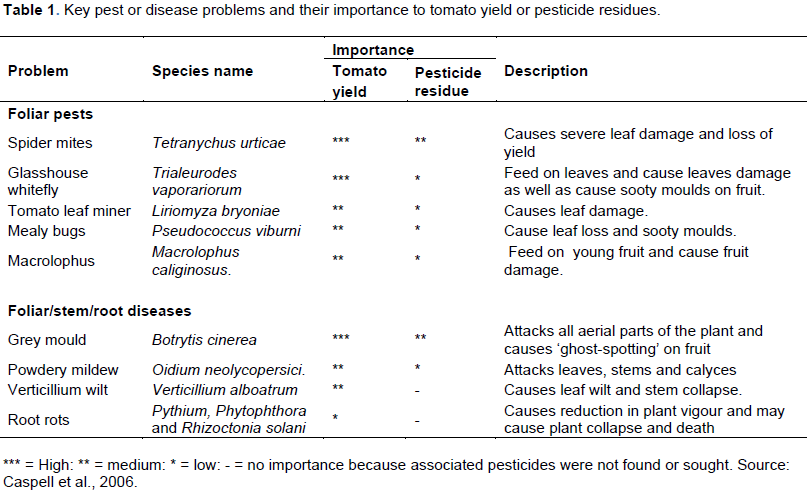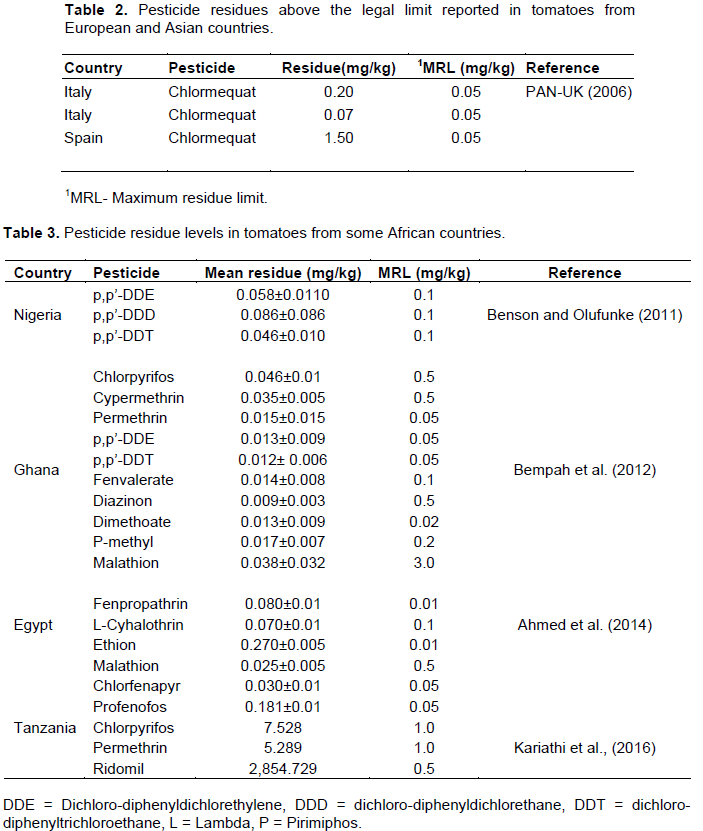Review
ABSTRACT
Tomato contributes the highest percent to the fruit and vegetables consumed in Tanzania. Its high consumption is attributed to the presence of bioactive compounds and vitamins known to prevent non-communicable diseases. Pesticides used to control pests and diseases cause direct accumulation of pesticide residues in food. Consumption of pesticide contaminated tomato increases the risk of pesticide exposure. This review is on types of pesticides used in tomato production, health effects of pesticides, levels of pesticide residues in tomatoes, dietary pesticide exposure, awareness on pesticides effects and preventive measures as well as policies governing pesticide use in Tanzania. Clearly, there is evidence of extensive use of pesticides in tomato production, limited knowledge regarding pesticide use, as well as weak regulatory framework for pesticide use. Importantly, levels of pesticide residues in tomatoes consumed in Tanzania exceed the recommended maximum residual limits. In order to assure pesticide safety of food, there is a need to identify and control farmers' practices which are highly associated with pesticide contamination in tomatoes.
Key words: Contamination, exposure, pesticide, residues, tomato.
INTRODUCTION
PESTICIDES USED IN TOMATO PRODUCTION


REGULATION OF PESTICIDE RESIDUES IN FOODS
CONCLUSIONS
CONFLICT OF INTEREST
REFERENCES
|
Abang A, Kouame C, Abang M, Hannah R, Fotso A (2013). Vegetable growers' perception of pesticide use practices, cost, and health effects in the tropical region of Cameroon. Int. J. Agron. Plant Prod. 4(5):873-883. |
|
|
Agriculture-Consumer-Protection (2001). Report of the Codex Committee on Pesticide Residues. |
|
|
Aktar W, Sengupta D, Chowdhury A (2009). Impact of pesticides use in agriculture: their benefits and hazards. Interdiscip. Toxicol. 2(1):1-12. |
|
|
Al-Waili N, Salom K, Al-Ghamdi A, Ansari MJ (2012). Antibiotic, pesticide, and microbial contaminants of honey: human health hazards. Sci. World J. 9p. |
|
|
Alphonce R, Alfnes F (2012). Consumer willingness to pay for food safety in Tanzania: an incentiveâ€aligned conjoint analysis. Int. J. Consum. Stud. 36(4):394-400. |
|
|
Baig SA, Akhtera NA, Ashfaq M, Asi MR (2009). Determination of the organophosphorus pesticide in vegetables by high-performance liquid chromatography. Am. Eurasian J. Agric. Environ. Sci. 6(5):513-519. |
|
|
Barrett JR (2005). More Concerns for Farmers: Neurologic Effects of Chronic Pesticide Exposure. Environ. Health Perspect. 113(7):A472. Capsicum annuum L.: A market survey in Nigeria. Afr. J. Environ. Sci. Technol. 5(6):437-442. |
|
|
Busindi I. (2012). Innovative communication pathways in dissemination of agricultural technologies and improving market information in Tanzania: A case of tomato value chains. Sokoine University of Agriculture, Morogoro. |
|
|
Canene-Adams K, Campbell JK, Zaripheh S, Jeffery EH, Erdman JW (2005). The tomato as a functional food. J. Nutr. 135(5):1226-1230. |
|
|
Caspell N, Drakes D, O'Neil lT (2006) Food Standards Agency Pesticide Residue Minimisation Crop Guide: Tomatoes. ADAS & FSA. |
|
|
Codex (2013). Pesticide Residues in Food and Feed. In FAO/WHO (Ed.), VO 0448 – Tomato: FAO/WHO. |
|
|
Damalas CA, Eleftherohorinos IG (2011). Pesticide exposure, safety issues, and risk assessment indicators. Int. J. Environ. Res. Public Health 8(12):1402-1419. |
|
|
Dewhurst IC, Marrs TC (2009). Toxicology of Pesticides General, Applied and Systems Toxicology. . (Vol. 6). Chennai India: John Wiley& Sons ,Ltd. http://dx.doi.org/10.1002/9780470744307.gat140 |
|
|
Dougherty CP, Holtz SH, Reinert JC, Panyacosit L, Axelrad DA, Woodruff TJ (2000). Dietary exposures to food contaminants across the United States. Environ. Res. 84(2):170-185. |
|
|
Engindeniz S (2006). Economic analysis of pesticide use on processing tomato growing: A case study for Turkey. Crop Protect. 25(6):534-541. |
|
|
ESRF (2010). Strengthening microâ€enterprises in Tanzania: The case of smallâ€scale vegetable farmers in Arusha. Dar es Salaam: Economic and Social Research Foundation (ESRF). |
|
|
Essumang DK, Dodoo DK, Adokoh CK, Fumador EA (2008). Analysis of some pesticide residues in tomatoes in Ghana. Hum. Ecol. Risk Assess. 14(4):796-806. |
|
|
Frusciante L, Carli P, Ercolano MR, Pernice R, Di Matteo A, Fogliano V, Pellegrini N (2007). Antioxidant nutritional quality of tomato. Mol. Nutr. Food Res. 51(5):609-617. |
|
|
Gilden RC, Huffling K, Sattler B (2010). Pesticides and health risks. J. Obstet. Gynecol. Neonatal Nurs. 39(1):103-110. |
|
|
Gimou MM, Charrondiere U, Leblanc JC., Pouillot R (2008). Dietary exposure to pesticide residues in Yaoundé: the Cameroonian total diet study. Food Addit. Contam. 25(4):458-471. |
|
|
Gupta RC (2011). Toxicology of organophosphate & carbamate compounds: Academic Press. |
|
|
Hamilton D, Crossley S (2004). Pesticide residues in food and drinking water: human exposure and risks: John Wiley & Sons. |
|
|
Wang HS, Sthiannopkao S, Du J, Chen ZJ, Kim KW, Yasin MS, Hashim JH, Wong CK, Wong MH (2011). Daily intake and human risk assessment of organochlorine pesticides (OCPs) based on Cambodian market basket data. J. Hazard. Mater. 192(3):1441-1449. |
|
|
Hossain S, Hossain A, Rahman A, Islam M, Rahman A, Adyel TM (2013). Health risk assessment of pesticide residues via dietary intake of market vegetables from Dhaka, Bangladesh. Foods 2(1):64-75. |
|
|
Ibitayo O, Monosson E (2007). Agricultural pesticide contamination. în: Encyclopedia of Earth. Eds. Cutler J. Cleveland (Washington, DC: Environmental Information Coalition, National Council for Science and the Environment). |
|
|
Kamel F, Hoppin J. A. (2004). Association of pesticide exposure with neurologic dysfunction and disease. Environ. Health Perspect. 112(9):950-958. |
|
|
Kariathi V, Kassim N, Kimanya M (2016). Pesticide exposure from fresh tomatoes and its relationship with pesticide application practices in Meru district. Cogent Food Agric. 2(1):1196808. |
|
|
Keikotlhaile BM, Spanoghe P (2011). Pesticide residues in fruits and vegetables. Pesticides: formulations, effects, fate. pp. 243-252. |
|
|
Kihampa C, Mato RR, Mohamed H (2010a). Levels of pesticide |
|
|
Kihampa C, Mato RR, Mohamed H (2010b). Residues of Organochlorinated Pesticides in Soil from Tomato Fields, Ngarenanyuki, Tanzania. J. Appl. Sci. Environ. Manage. 14(3). |
|
|
Kwon H, Kim TK., Hong SM., Se EK, Cho NJ, Kyung KS (2015). Effect of household processing on pesticide residues in field-sprayed tomatoes. Food Sci. Biotechnol. 24(1):1-6. |
|
|
Larcher A (2005). Costs of agri-food safety and SPS compliance: United Republic Of Tanzania, Mozambique And Guinea Tropical Fruits |
|
|
Litchfield MH (2005). Estimates of acute pesticide poisoning in agricultural workers in less developed countries. Toxicol. Rev. 24(4):271-278 |
|
|
Matthews G (2006). Pesticides and agricultural development: Wiley Online Library. |
|
|
Mdegela RH, Mosha RD, Ngowi HA, Nonga H (2013). Environmental and Health Impacts Associated with Usage of Agrochemicals in Mindu Dam Catchment Area, Morogoro, Tanzania. 15(0856):18. |
|
|
Mekonen S, Ambelu A, Spanoghe P (2014). Pesticide residue evaluation in major staple food items of Ethiopia using the Quechers method: A case study from the Jimma zone. Environ. Toxicol. Chem. 33(6):1294-1302. |
|
|
Ministry of Agriculture Food Security and Cooperatives, Ministry of Livestock Development and Fisheries, Ministry of Water and Irrigation, Ministry of Agriculture, Livestock and Environment-Zanzibar, Prime Minister's Office, Regional Administration and Local Governments, Ministry of Industries, Trade and Marketing, The National Bureau of Statistics and the Office of the Chief Government Statistician Z. (2012). National sample census of agriculture small holder agriculture (Vol. Volume II ): CROP SECTOR – NATIONAL REPORT. |
|
|
MMA (2008). Fresh vegetables for local market sub sector analysis Tanzania. Dar es Salaam: Match Maker Associates Limited MMA and Small and Medium Interprises Competitiveness Facility SCF. |
|
|
Mushobozi WL (2010). Good Agricultural Practices (GAP) on horticultural production for extension staff in Tanzania FAO GAP WORKING PAPER SERIES Rome,Italy: FAO. |
|
|
MUVI-SIDO (2009). Iringa Tomato Value Chain Analysis for Local (National) Market and Value Chain Development Investment Plan: Muunganisho wa Ujasiriamali Vijijini- Small Industry Development Organization MUVI-SIDO. |
|
|
Ngigi MW, Okello JJ, Lagarkvist C, Karanja N, Mburu J (2010). Assessment of developing-country urban consumers' willingness to pay for quality of leafy vegetables: The case of middle and high income consumers in Nairobi, Kenya. |
|
|
Ngowi A, Mbise T, Ijani A, London L, Ajayi O (2007). Smallholder vegetable farmers in Northern Tanzania: Pesticides use practices, perceptions, cost and health effects. Crop Protect. 26(11):1617-1624. |
|
|
Ngowi VA (2002). Health impact of exposure to pesticides in agriculture in Tanzania: Tampere University Press |
|
|
Nonga H, Mdegela R, Lie E, Sandvik M, Skaare J (2011). Assessment of farming practices and uses of agrochemicals in Lake Manyara basin, Tanzania. Afr. J. Agric. Res. 6(10):2116-2130. |
|
|
Ntow WJ, Gijzen HJ, Kelderman P, Drechsel P (2006). Farmer perceptions and pesticide use practices in vegetable production in Ghana. Pest Manage. Sci. 62(4):356-365. |
|
|
Oates L, Cohen M (2011). Assessing diet as a modifiable risk factor for pesticide exposure. Int. J. Environ. Res. Public Health 8(12):1792-1804. |
|
|
Owen LA, Pickering KT (2006). An introduction to global environmental issues: Routledge. |
|
|
Pavel VL, Sobariu DL, Tudorache Fertu I, Statescu F, Gaverilescu M (2013). Symbiosis in the environment biomanagement of soils contaminated with heavy metals. Eur. J. Sci. Theol. 9:211-224. |
|
|
Petersen A, Jensen BH (2012). Pesticide Residues Results from the period 2004-2011 (N. Food Chemistry, Toxicology and Risk |
|
|
Pogăcean MO, Hlihor RM, Preda C, Gavrilescu M (2013). Humans in the environment: comparative analysis and assessment of pesticide residues from field-grown tomatoes. Eur. J. Sci. Theol. 9(6):79-94. |
|
|
Price C (2008). Implications of pesticide residues in inter-rated ditch-duke farming. Cent Thail Aquic News, 32:23 |
|
|
PSEP (2012). Toxicity of Pesticides. In C. University (Ed.), Part of the Pesticide Management Education Program: Pesticide Safety Education Program (PSEP). |
|
|
Putter HD, van Koesveld M, de Visser C (2007). Overview of the vegetable sector in Tanzania. A_friVeg Proj ect Report, 1. |
|
|
Raffo A, Leonardi C, Fogliano V, Ambrosino P, Salucci M, Gennaro L, Bugianesi R, Giuffrida F, Quaglia G (2002). Nutritional value of cherry tomatoes (Lycopersicon esculentum cv. Naomi F1) harvested at different ripening stages. J. Agric. Food Chem. 50(22):6550-6556. Raiola A, Rigano MM, Calafiore R, Frusciante L, Barone A (2014). Enhancing the Health-Promoting Effects of Tomato Fruit for Biofortified Food. Mediators of inflammation, 1. |
|
|
Sithanantham S, Seif A, Ssennyonga J, Matoka C, Mutero C (2002). Integrated Pest Management (IPM) Issues in Irrigated Agriculture: Current Initiatives and Future Needs to Promote IPM Adoption by Smallholder Farmers in Eastern Africa. The Changing Face of Irrigation in Kenya: Opportunities for Anticipating Changes in Eastern and Southern Africa. P 231. |
|
|
Smit ZK, Indjic D, Belic S, Miloradov M (2002). Effect of water quality on physical properties and biological activity of tank mix insecticide-fungicide spray. In II Balkan Symposium on Vegetables and Potatoes 579:551-556. |
|
|
Smith FI, Eyzaguirre P (2007). African leafy vegetables: their role in the world health organization's global fruit and vegetables initiative. Afr. J. Food Agric. Nutr. Dev. 7(3):1-17. |
|
|
Solecki R, Davies L, Dellarco V, Dewhurst I, Van Raaij M, Tritscher A (2005). Guidance on setting of acute reference dose (ARfD) for pesticides. Food Chem. Toxicol. 43(11):1569-1593. |
|
|
Tebourbi O, Rhouma KB., Sakly M (2011). Pesticides in the Modern World - Pests Control and Pesticides Exposure and Toxicity Assessment INTECH Open Access Publisher. |
|
|
TPRI (2007). List of pesticides registered in Tanzania. Arusha - Tanzania: Tropical Pesticides Research Institute. |
|
|
Tsipi D, Botitsi H, Economou A (2015). Pesticide Chemistry and Risk Assessment. Mass Spectrometry for the Analysis of Pesticide Residues and Their Metabolites. pp. 1-34. |
|
|
Weselak M, Arbuckle TE, Wigle DT, Krewski D (2007). In utero pesticide exposure and childhood morbidity. Environ. Res. 103(1):79-86. |
|
|
WHO (2010). The WHO recommended classification of pesticides by hazard and guidelines to classification 2009. |
|
Copyright © 2024 Author(s) retain the copyright of this article.
This article is published under the terms of the Creative Commons Attribution License 4.0